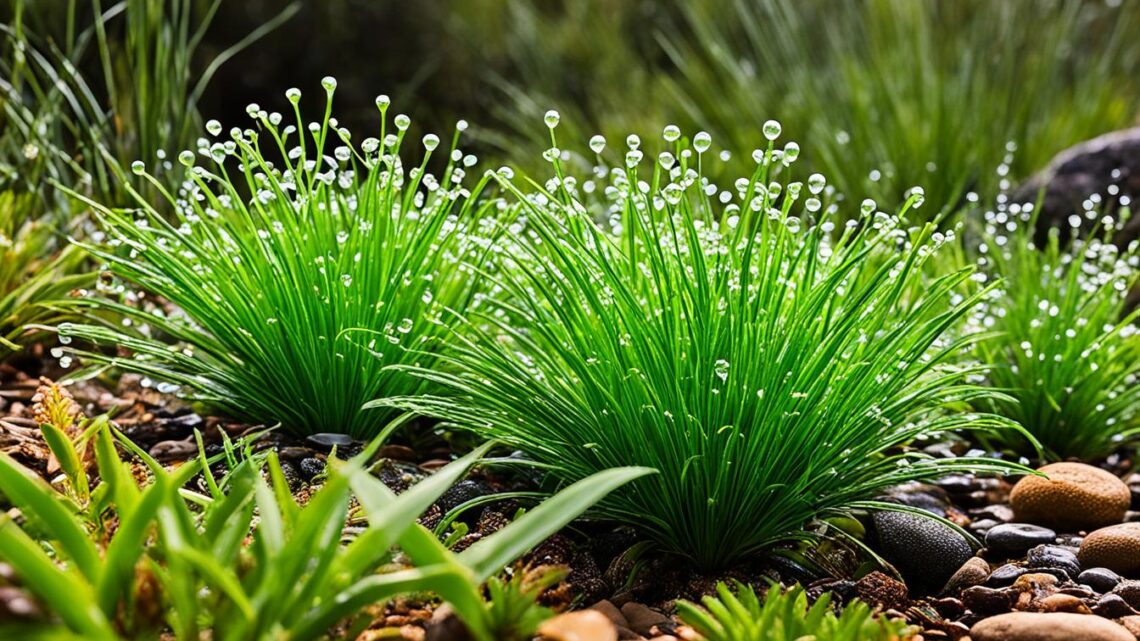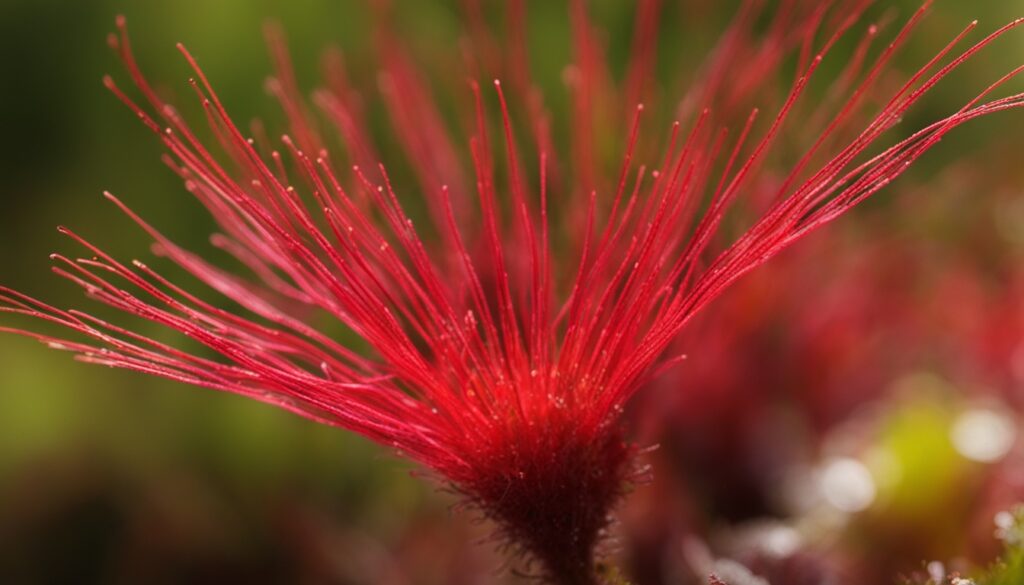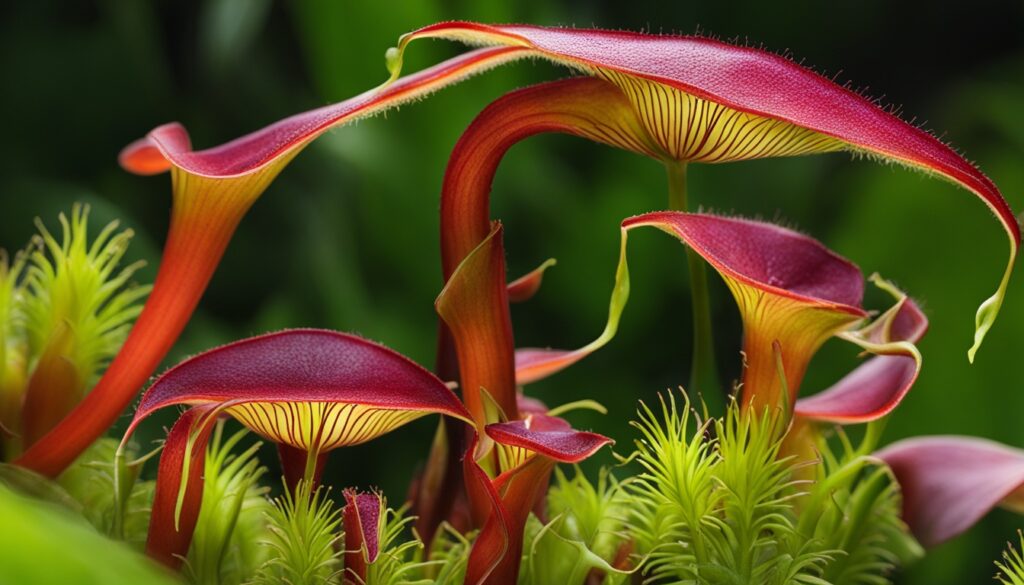
Have you heard of the «rainbow plants» in Australia? The Byblis genus is truly fascinating. It has grabbed the interest of plant lovers and scientists. These are carnivorous plants that stand out for their look and how they survive. Let’s dive into the incredible world of Byblis, belonging to Australia and New Guinea.
What do these plants have to offer? You’ll soon find out about their unique features. Join us as we explore the story of these amazing plants in Australia’s rich plant life.
Unveiling the Enigmatic Byblis Genus
The Byblis genus is from Australia and has eight known species. They are called «rainbow plants» because of the shiny drops on their leaves. These drops, similar to a rainbow, entice and catch small insects for food.
Introducing the Rainbow Plants of Australia
These carnivorous plants make up a special group in Australia. Their leaves shine brightly, looking like rainbows. This shiny layer helps them attract and catch insects to eat.
Taxonomic Classification and Evolutionary Origins
The Byblis genus is part of the Lamiales order. It’s related to the Martyniaceae, Lentibulariaceae, and Gesneriaceae families. They first appeared in the middle Eocene, with a seed fossil found in South Australia.
| Taxonomic Rank | Classification |
|---|---|
| Order | Lamiales |
| Family | Martyniaceae, Lentibulariaceae, Gesneriaceae |
| Genus | Byblis |
| Species | 8 recognized species |
The Byblis genus remains a puzzle, charming both scientists and plant lovers. We’re still discovering their secrets, making them even more interesting among carnivorous plants.

Byblis: A Genus of Carnivorous Marvels
The Byblis genus is a group of Byblis carnivorous plants. They use a trap known as the «passive flypaper trap.» It catches and digests small insects like fruit flies. Unlike many other carnivorous plants, Byblis plants can’t actively move to catch their prey.
Instead, they use their sticky, slimy leaves to catch the insects. This shows off their clever and unique way of catching food.
Byblis plants are often called the «rainbow plants» because of their color and their origin in Australia. They live in places where getting nutrients is hard. So, they catch insects to get the food they need to grow.
What makes Byblis special is how it catches its food. Its leaves are full of a sticky substance. This goo is like flypaper, trapping any insects that touch it. Then, the plant uses enzymes to turn the insects into food that it can absorb. This way of catching food uses little energy. It’s a smart and effective method in the world of carnivorous plants.

The Byblis genus is an amazing example of how plants can evolve to survive. These plants have developed unique ways to find food where it’s hard to come by. By studying how Byblis works, we learn more about the amazing variety and strength of plants.
Leaf Structure and Trapping Mechanism
The Byblis genus is known as the «rainbow plants» in Australia. They have unique leaves and a way to catch insects. Their long, round leaves have sticky hairs. These hairs make a substance that lures insects to their doom.
Glandular Hairs and Mucilaginous Secretions
Byblis plants don’t move to catch prey like sundews. They use a passive method, acting like flypaper for bugs. Their leaves have glands that make enzymes for digesting insects. This helps the plant get nutrients from its prey.
Research has found a big range in gland lengths on Byblis leaves. In one species, the glands on top of the leaf were 0.58 ± 0.24 mm in Byblis-1, 0.63 ± 0.25 mm in Byblis-2, and 1.05 ± 0.70 mm in Byblis-3. The glands underneath were 0.69 ± 0.24 mm long in Byblis-1, 0.75 ± 0.29 mm in Byblis-2, and 0.87 ± 0.46 mm in Byblis-3.
The differences in gland length show unique features in each Byblis species. How many sticky hairs there are is also important for catching insects.
Byblis plants use sticky hairs and a special substance to catch insects. This helps them live well in Australia. They are part of the rich web of carnivorous plants in Australia.
Floral Biology and Pollination Strategies
The Byblis genus, known as «rainbow plants,» is from Australia. It has flowers designed for many pollination methods. The flowers are five-petaled and single, appearing from spring to summer.
Buzz Pollination and Floral Adaptations
Many Byblis plants use «buzz pollination.» This means insects like bees make the flowers shake. When this happens, pollen is released from the flower’s anthers. The B. gigantea and B. liniflora species have curved stamens and pistil to help with this.
The design of Byblis’s reproductive parts is key for attracting pollinators. This layout improves the chances of pollen being carried to other plants. It ensures successful plant reproduction.
| Pollination Strategy | Floral Adaptations | Pollinator Types |
|---|---|---|
| Buzz Pollination |
|
|
The interaction between Byblis flowers and pollinators shows how these plants have evolved. Knowing about Byblis floral biology and pollination strategies teaches us about the success of buzz pollination in Australia’s various environments.
Byblis Species and Their Unique Characteristics
The Byblis genus has eight known species, each unique. They’re found in diverse parts of Australia. And there could be more waiting to be found.
B. gigantea: The Giant of the Southwest
Byblis gigantea and B. lamellata are among the tallest in the group. They can grow up to 70 cm high, known as «The Giant of the Southwest.» These perennial plants handle the heat of their region by resting in summer.
B. liniflora: The Widespread Annual
The Byblis liniflora group includes annual plants like B. liniflora. They live for just one season, yet their beauty is well-loved. They are admired by both plant lovers and scientists.
| Species | Growth Habit | Habitat | Key Characteristics |
|---|---|---|---|
| Byblis gigantea | Perennial | Southwestern Australia | Largest species, reaching up to 70 cm in height, undergoes summer dormancy |
| Byblis liniflora | Annual | Widespread across Australia | Delicate, completing lifecycle within a single growing season, known for their beauty |
The Byblis genus is full of interesting plants. There are tall ones and delicate ones. Each plant shows off how clever the genus is, drawing attention from scientists and fans.
Habitats and Distribution Across Australia
The Byblis genus is known as the «rainbow plants of Australia.» They grow within Australia’s borders, and some reach surrounding regions. These beautiful carnivorous plants live in wet places like bogs and marshes.
They need sandy, moist soil and lots of sunlight. The Byblis genus has six species. Four are annual and found in northern Australia and New Guinea.
There’s also a perennial species, Byblis gigantea, It’s found in the southwest of Western Australia. B. gigantea shows big differences in how it looks, where it grows, and how its seeds look.
Byblis gigantea is a small, 45 cm tall shrub in Western Australia’s southwest. Its numbers are falling because of land clearing. On the other hand, Byblis liniflora is an annual plant.
It’s scattered in the north of Western Australia, the Northern Territory, and Queensland. It’s also seen in places like Indonesia and Papua New Guinea.
There’s also Byblis aquatica. It’s only found within 40 km of Darwin in the Northern Territory. Byblis plants are found in Western Australia, the Northern Territory, and Queensland.
| Byblis Species | Distribution | Habitat |
|---|---|---|
| Byblis gigantea | Southwest Western Australia | Bog and marsh environments, sandy soils |
| Byblis liniflora | Northern Australia, southern Indonesia, Papua New Guinea | Melaleuca floodplains, heathlands, forest edges |
| Byblis aquatica | Northern Territory (within 40 km of Darwin) | Bog and marsh environments |
The Byblis plants aren’t threatened right now. But, Byblis aquatica and others could be in danger soon. This is because of land clearing and sand digging near cities.
People are studying and working to protect these unique plants. They want to ensure these plants can continue growing in their Australian homes.
Environmental Threats and Conservation Efforts
All Byblis species, native to Australia, are legally protected. Yet, urban sprawl and agriculture harm some, like B. gigantea and B. lamellata. Such harm makes them endangered, with B. gigantea critically so.
Wetlands are drained for farming, hurting these plants. Important efforts are in place to save them and their homes.
Urban Sprawl and Habitat Loss
Urban growth and farming take over nature, threatening Byblis plants in Australia. As we build more and farms spread, their homes shrink. The loss of wetlands is particularly hard on them, pushing some towards extinction.
A recent study looked at 860 carnivorous plant species worldwide. It found 8% were almost gone, 6% in danger, and 12% at risk. Destroying forests for cities and farms, and stealing them for sale, are big problems.
People are now working harder to keep these plants safe. They’re fixing habitats, teaching the public, and making strict rules about harvesting and selling. This work is to save these special species for the future.
Cultivation and Care for the Enthusiast
For fans of carnivorous plants, Australia’s Byblis sundews are a top pick. These plants awe enthusiasts but are tricky to grow. With special care, Byblis plants can do well in caring hands.
Most Byblis varieties you’ll find are grown, not wild. B. filifolia and B. liniflora are often seen. Other species need to be grown from seeds, which are sometimes wild-collected. To grow them well, one must keep the soil moist and poor in nutrients, provide high humidity, and offer the right amount of light.
Soil and Substrate
- Byblis plants like well-draining, poor soil like peat, perlite, and sand mix.
- Keep the soil moist without making it soggy to reflect their natural living conditions.
- Don’t use regular potting soils, they have too many nutrients for Byblis.
Lighting and Temperature
- Byblis needs plenty of sunlight, around 6 hours direct exposure daily.
- If sunlight is limited, consider adding artificial light to make up the deficit.
- They do best in 60°F to 85°F, but they can handle as low as 38°F or as high as 100°F for a bit.
Humidity and Watering
- High humidity, between 50% to 85%, is key for healthy Byblis plants.
- Keep the soil moist, but not soaked, by watering them often.
- Never let the soil completely dry out, as it can hurt the plants.
With the right efforts, fans of carnivorous plants can have their own Byblis at home. These Australian sundews can be a joy for a long time if given the right care.
Byblis: Unique Adaptations in the Carnivorous World
The Byblis genus shines in the world of carnivorous plants. It uses a unique way to catch insects. Instead of moving, it features a «flypaper» method. This means their leaves are sticky and insects get caught like on sticky paper.
Byblis plants are known as «rainbow plants» because of their shiny leaves. They appeal to insects, including mosquitoes and fruit flies. There are eight kinds of Byblis. One called Byblis guehoi is often grown by plant lovers. They like lots of sun and need plenty of water to stay healthy.
The Byblis genus shows the incredible variety in carnivorous plants. They catch insects without moving, making them stand out. This method is similar to other famous plants like the Drosera. By studying these plants, we learn a lot about how plants and bugs interact.



